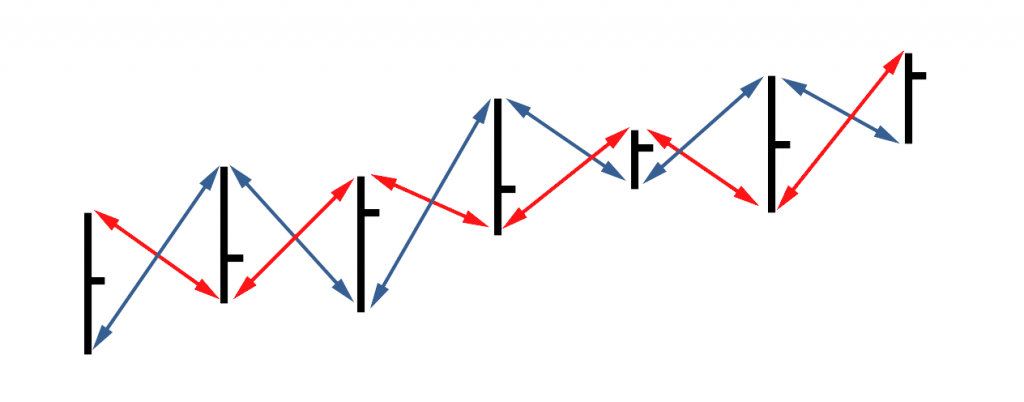R&D Blog
Vortex Indicator | Trading Strategy (Entry)
I. Trading Strategy
Developer: Etienne Botes and Douglas Siepman. Source: The Vortex Indicator. Stocks & Commodities, January 2010. Concept: Momentum trading strategy based on Vortex Indicator. Research Goal: Performance verification of momentum signals. Specification: Table 1. Results: Figure 1-2. Trade Setup: Long Setup: Positive Vortex Indicator (+VI) crosses above Negative Vortex Indicator (−VI). Short Setup: Negative Vortex Indicator (−VI) crosses above Positive Vortex Indicator (+VI). Trade Entry: Table1. Trade Exit: Table 1. Portfolio: 42 futures markets from four major market sectors (commodities, currencies, interest rates, and equity indexes). Data: 40 years since 1980. Testing Platform: MATLAB®.
II. Sensitivity Test
All 3-D charts are followed by 2-D contour charts for Profit Factor, Sharpe Ratio, Ulcer Performance Index, CAGR, Maximum Drawdown, Percent Profitable Trades, and Avg. Win / Avg. Loss Ratio. The final picture shows sensitivity of Equity Curve.
Tested Variables: Look_Back & Time_Index (Definitions: Table 1):
Figure 1 | Portfolio Performance (Inputs: Table 1; Commission & Slippage: $0).
| STRATEGY | SPECIFICATION | PARAMETERS |
| Auxiliary Variables: | True Range (TR): TR[i] = max(High[i], Close[i − 1]) − min(Low[i], Close[i − 1]); Vortex Indicator (VI): +VM[i] = |High[i], Low[i − 1]); −VM[i] = |Low[i], High[i − 1]); +VMS[i] = sum(+VM over the Look_Back period); −VMS[i] = sum(−VM over the Look_Back period); TRS[i] = sum(TR over the Look_Back period); +VI[i] = +VMS[i] / TRS[i]; −VI[i] = −VMS[i] / TRS[i]; Index: i ~ Current Bar. | Look_Back = [20, 200], Step = 5; |
| Setup: | Long Trades: (+VI[i] > −VI[i]) & (+VI[i − 1] ≤ −VI[i − 1]); Short Trades: (−VI[i] > +VI[i]) & (−VI[i − 1] ≤ +VI[i − 1]); Index: i ~ Current Bar. | |
| Filter: | N/A | |
| Entry: | Extreme Point Rule: The extreme point is: (a) the highest point of a session when +VI[i] crosses above −VI[i]; (b) the lowest point of a session when −VI[i] crosses above +VI[i]. A buy/sell signal is triggered when a price moves beyond the extreme point. Index: i ~ Current Bar. | |
| Exit: | Time Exit: nth day at the close, n = Time_Index. Stop Loss Exit: ATR(ATR_Length) is the Average True Range over a period of ATR_Length. ATR_Stop is a multiple of ATR(ATR_Length). Long Trades: A sell stop is placed at [Entry − ATR(ATR_Length) * ATR_Stop]. Short Trades: A buy stop is placed at [Entry + ATR(ATR_Length) * ATR_Stop]. | Time_Index = [1, 196], Step = 5; ATR_Length = 20; ATR_Stop = 6; |
| Sensitivity Test: | Look_Back = [20, 200], Step = 5 Time_Index = [1, 196], Step = 5 | |
| Position Sizing: | Initial_Capital = $1,000,000 Fixed_Fractional = 1% Portfolio = 42 US Futures ATR_Stop = 6 (ATR ~ Average True Range) ATR_Length = 20 | |
| Data: | 42 futures markets; 40 years (1980/01/01−2020/2/28) |
Table 1 | Specification of Trading Strategy.
III. Sensitivity Test with Commission & Slippage
Tested Variables: Look_Back & Time_Index (Definitions: Table 1):
Figure 2 | Portfolio Performance (Inputs: Table 1; Commission & Slippage: $100 Round Turn).
IV. Benchmarking
We benchmark the base case strategy against alternatives:
Case #1: Look_Back = 20; Time_Index = ∞ (i.e. no time exit).
Case #2: Look_Back = 50; Time_Index = ∞ (i.e. no time exit).
Case #3: Look_Back = 80; Time_Index = ∞ (i.e. no time exit).
Case #4: Look_Back = 110; Time_Index = ∞ (i.e. no time exit).
| Fixed Fractional Sizing | Case #1 | Case #2 | Case #3 | Case #4 |
| Net Profit ($) | 2,251,344 | 56,325,466 | 77,004,860 | 367,959,128 |
| Sharpe Ratio | 0.24 | 0.56 | 0.59 | 0.77 |
| Ulcer Performance Index (UPI) | 0.09 | 0.42 | 0.48 | 0.82 |
| Profit Factor | 1.01 | 1.05 | 1.06 | 1.09 |
| CAGR (%) | 2.98 | 10.61 | 11.46 | 15.86 |
| Max. Drawdown (%) | (85.34) | (61.73) | (71.21) | (61.64) |
| Percent Profitable Trades (%) | 32.24 | 29.93 | 29.48 | 29.41 |
| Avg. Win / Avg. Loss Ratio | 2.12 | 2.47 | 2.53 | 2.60 |
Table 2 | Inputs: Table 1; Fixed Fractional Sizing: 1%; Commission & Slippage: $100 Round Turn.
V. Basic Concepts
E. Botes, D. Siepman, Stocks & Commodities (2010):
The greater the distance from yesterday’s low to today’s high, the stronger the upward (or positive) vortex. Similarly, the greater the distance between yesterday’s high and today’s low, the stronger the downward (or negative) vortex.
VI. Rating: Vortex Indicator | Trading Strategy
A/B/C/D
VII. Summary
(a) A simple trading strategy based on Vortex Indicator is an average momentum model requiring more development; (b) Longer holding periods are preferred, i.e. Time_Index > 50 bars.
Related Entries: Dual Momentum & Vortex Indicator (Entry) | Fractal Adaptive Moving Average (Setup) | Simple Moving Average Filter (Entry & Exit)
Related Topics: (Public) Trading Strategies
CFTC RULE 4.41: HYPOTHETICAL OR SIMULATED PERFORMANCE RESULTS HAVE CERTAIN LIMITATIONS. UNLIKE AN ACTUAL PERFORMANCE RECORD, SIMULATED RESULTS DO NOT REPRESENT ACTUAL TRADING. ALSO, SINCE THE TRADES HAVE NOT BEEN EXECUTED, THE RESULTS MAY HAVE UNDER-OR-OVER COMPENSATED FOR THE IMPACT, IF ANY, OF CERTAIN MARKET FACTORS, SUCH AS LACK OF LIQUIDITY. SIMULATED TRADING PROGRAMS IN GENERAL ARE ALSO SUBJECT TO THE FACT THAT THEY ARE DESIGNED WITH THE BENEFIT OF HINDSIGHT. NO REPRESENTATION IS BEING MADE THAT ANY ACCOUNT WILL OR IS LIKELY TO ACHIEVE PROFIT OR LOSSES SIMILAR TO THOSE SHOWN.
RISK DISCLOSURE: U.S. GOVERNMENT REQUIRED DISCLAIMER | CFTC RULE 4.41
Codes: matlab/vortex/1






























